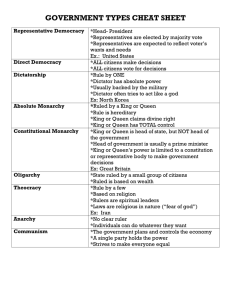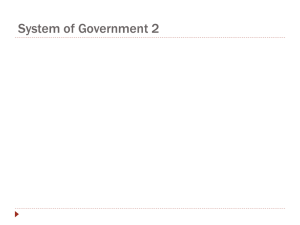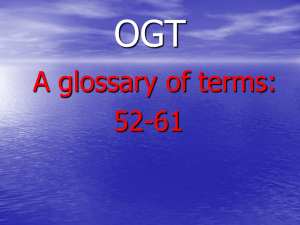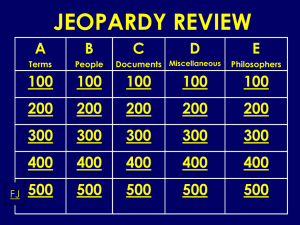Prentice Hall Chap 3 Section 4
advertisement
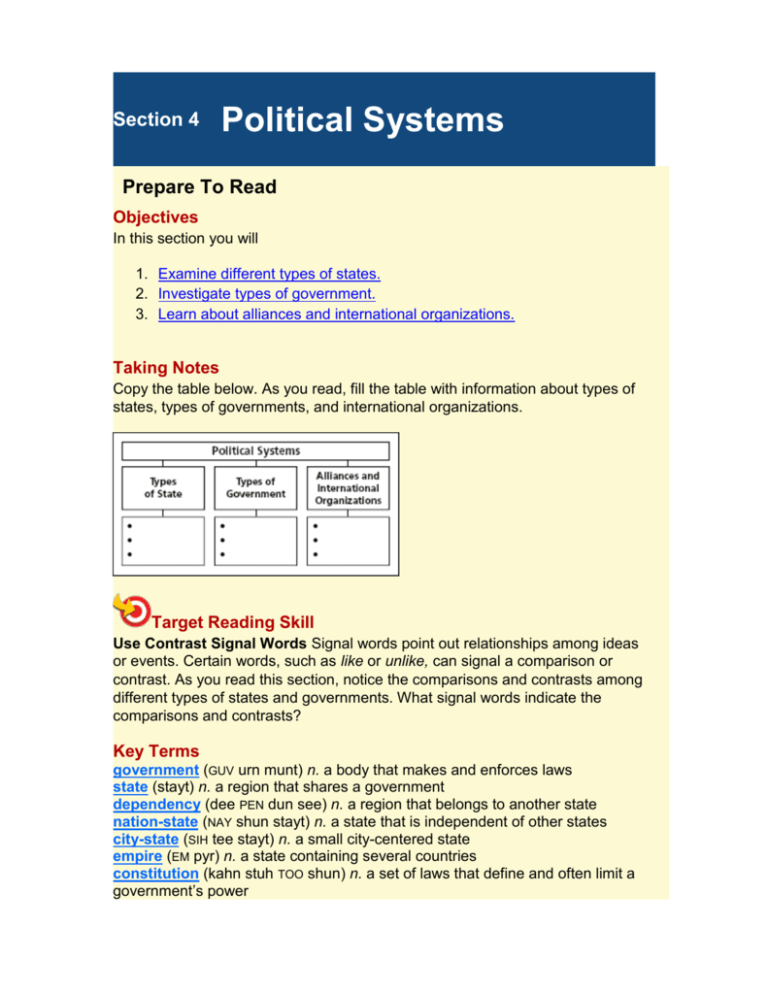
Section 4 Political Systems Prepare To Read Objectives In this section you will 1. Examine different types of states. 2. Investigate types of government. 3. Learn about alliances and international organizations. Taking Notes Copy the table below. As you read, fill the table with information about types of states, types of governments, and international organizations. Target Reading Skill Use Contrast Signal Words Signal words point out relationships among ideas or events. Certain words, such as like or unlike, can signal a comparison or contrast. As you read this section, notice the comparisons and contrasts among different types of states and governments. What signal words indicate the comparisons and contrasts? Key Terms government (GUV urn munt) n. a body that makes and enforces laws state (stayt) n. a region that shares a government dependency (dee PEN dun see) n. a region that belongs to another state nation-state (NAY shun stayt) n. a state that is independent of other states city-state (SIH tee stayt) n. a small city-centered state empire (EM pyr) n. a state containing several countries constitution (kahn stuh TOO shun) n. a set of laws that define and often limit a government’s power Chapter 3, Section 4 Types of States Long ago, most people lived in small, traditional communities. All adults took part in group decisions. Some small communities still make decisions this way, but they are now part of larger units called nations. Nations are too large for everyone to take part in every decision. Still, nations have to protect people and resolve conflicts between individuals and social groups. In modern nations, these needs are met by governments, or organizations that set up and enforce laws. You may remember that a region is an area united by a common feature. A state is a region that shares a government. You probably live in a state that is part of the United States. But the political units that we call “states” in the United States are just one kind of state. The entire United States can also be called a state. It is a region that shares a common government—the federal government. In 1994, Eritreans celebrated the first anniversary of their country’s independence. Dependencies and Nation-States Some regions are dependencies, or regions that belong to another state. Others, like the United States, are nation-states, or states that are independent of other states. Each has a common body of laws. Nation-states are often simply called nations. Every place in the world where people live is part of a nation-state or dependency. Target Reading Skill Use Contrast Signal Words The first sentence in the paragraph above begins with the word some. The second sentence begins with others. These words signal that a contrast will be made. What contrast is being made? Most nation-states are large, but some are tiny. The smallest is Vatican City, which is surrounded by the city of Rome in Italy. Vatican City covers only about 109 acres (44 hectares)! How States Developed The first real states formed in Southwest Asia more than 5,000 years ago when early cities set up governments. Small city-centered states are called citystates. Later, military leaders conquered large areas and ruled them as empires, or states containing several countries. After about 1500, European rulers founded the first true nation-states. European nations established dependencies all over the world. When those dependencies became independent, they formed new nation-states. Vatican City St. Peter’s Basilica, shown above, is the seat of the pope. He leads the Roman Catholic Church and rules Vatican City. Infer What must be true about Vatican City for it to be a nation-state? Reading Check What is the difference between a government and a state? Chapter 3, Section 4 Types of Government Each state has a government. There are many different kinds of government. Some governments are controlled by a single person or a small group of people. Others are controlled by all of the people. Direct Democracy The earliest governments were simple. People lived in small groups. They practiced direct democracy, a form of government in which all adults take part in decisions. Many towns in New England today practice direct democracy. Decisions are made at town meetings where all adult residents can speak and vote. Tribal Rule In time, communities banded together into larger tribal groups. Members of the tribe had a say in group decisions. But chiefs or elders usually made the final decision about what to do. Decisions were based upon the culture’s customs and beliefs. Absolute Monarchy Until about 200 years ago, one of the most common forms of government was absolute monarchy. In that system, a king or queen who inherits the throne by birth has complete control. Few absolute monarchies still exist today. Saudi Arabia and Brunei are two surviving absolute monarchies. Dictatorship There are other countries today, however, where just one person rules. A leader who is not a king or queen but who has almost total power over an entire country is called a dictator. Dictatorship is rule by such a leader. Nations ruled by dictators include Cuba, Libya, and North Korea. Dictatorships differ from absolute monarchies because most dictators don’t inherit power. Instead, they seize power. Dictators usually remain in power by using violence against their opponents. Dictators deny their people the right to make their own decisions. Kim Jong Il Kim Jong Il, the dictator of North Korea, making a rare public appearance. Analyze Images What group in North Korea might be a source of power for Kim Jong Il? Oligarchy Oligarchies are governments controlled by a small group of people. The group may be the leadership of a ruling political party. For example, China is an oligarchy controlled by the leadership of the Communist Party. There are other types of oligarchy. Myanmar, also called Burma, is run by a group of military officers. A group of religious leaders controls Iran. As in a dictatorship, ordinary people have little say in decisions. Constitutional Monarchy Most monarchies today are constitutional monarchies, or governments in which the power of the king or queen is limited by law. The United Kingdom, the Netherlands, and Kuwait are examples. These nations have constitutions, or sets of laws that define and often limit the government’s power. In a constitutional monarchy, the king or queen is often only a symbol of the country. Queen Beatrix of the Netherlands heads a constitutional monarchy. Representative Democracy Representative democracies are governments run by representatives that the people choose. Many constitutional monarchies are also representative democracies. In a representative democracy, the people indirectly hold power to govern and rule. They elect representatives who create laws. If the people do not like what a representative does, they can refuse to reelect that person. Citizens can also work to change laws they do not like. A constitution sets rules for elections, defines the rights of citizens, and limits the powers of the government. This system ensures that power is shared. The United States, Canada, and India are examples of representative democracies. Representative Democracy Members of the United States House of Representatives, shown above, are elected by the people of their districts. Contrast How does a representative democracy differ from a direct democracy? Reading Check What do absolute monarchies, dictatorships, and oligarchies have in common? Chapter 3, Section 4 International Organizations Nations may make agreements to work together in an alliance. Members of an alliance are called allies. Alliances provide for nations to assist each other with defense. For example, members of the North Atlantic Treaty Organization (NATO) have agreed to defend any fellow member who is attacked. Military bodies such as NATO are just one type of organization that is international, or involving more than one nation. Some international bodies are mainly economic in purpose. The European Union, for example, promotes economic unity among member nations in Europe. The United Nations is an international organization meant to resolve disputes and promote peace. Almost all nations of the world belong to the United Nations. Every member has a vote in the General Assembly of the United Nations. But only the United Nations Security Council can make decisions over the use of force. The United States and four other permanent members have the power to prevent action in the Security Council. The United Nations sponsors other international organizations with special purposes. For example, the Food and Agriculture Organization combats hunger worldwide. The United Nations Children’s Fund (UNICEF) promotes the rights and well-being of children. The United Nations headquarters in New York, New York Reading Check What is the purpose of the United Nations?
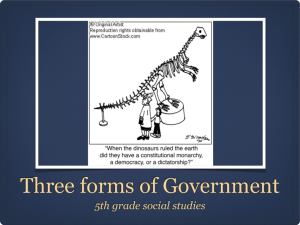
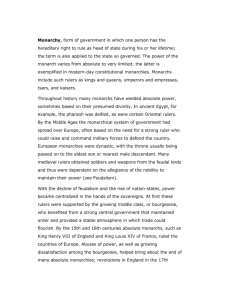
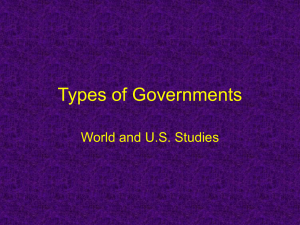
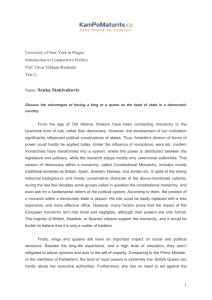
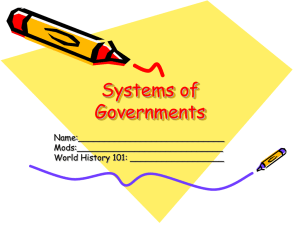
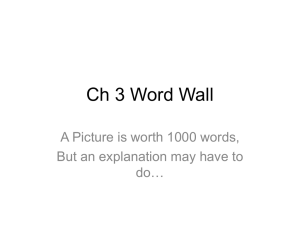
![“The Progress of invention is really a threat [to monarchy]. Whenever](http://s2.studylib.net/store/data/005328855_1-dcf2226918c1b7efad661cb19485529d-300x300.png)

